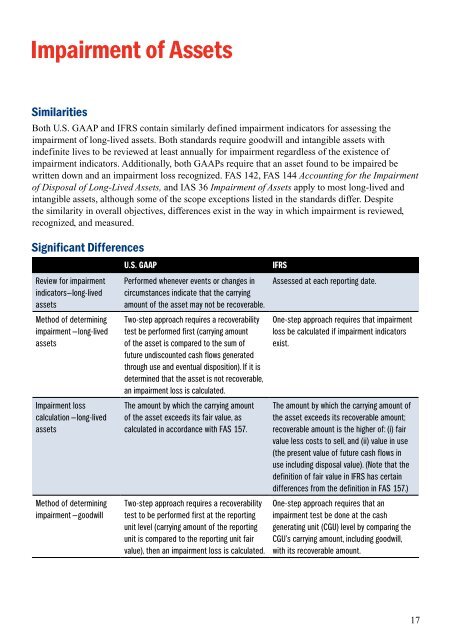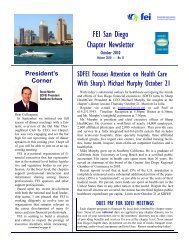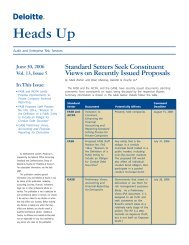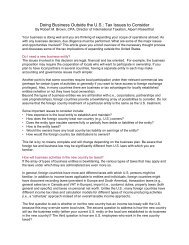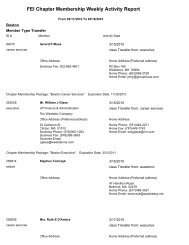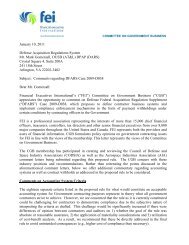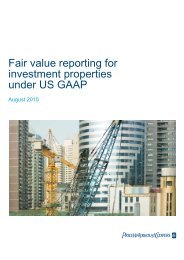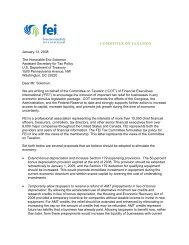U.S. GAAP v. IFRS: The Basics - Financial Executives International
U.S. GAAP v. IFRS: The Basics - Financial Executives International
U.S. GAAP v. IFRS: The Basics - Financial Executives International
You also want an ePaper? Increase the reach of your titles
YUMPU automatically turns print PDFs into web optimized ePapers that Google loves.
Impairment of Assets<br />
Similarities<br />
Both U.S. <strong>GAAP</strong> and <strong>IFRS</strong> contain similarly defined impairment indicators for assessing the<br />
impairment of long-lived assets. Both standards require goodwill and intangible assets with<br />
indefinite lives to be reviewed at least annually for impairment regardless of the existence of<br />
impairment indicators. Additionally, both <strong>GAAP</strong>s require that an asset found to be impaired be<br />
written down and an impairment loss recognized. FAS 142, FAS 144 Accounting for the Impairment<br />
of Disposal of Long-Lived Assets, and IAS Impairment of Assets apply to most long-lived and<br />
intangible assets, although some of the scope exceptions listed in the standards differ. Despite<br />
the similarity in overall objectives, differences exist in the way in which impairment is reviewed,<br />
recognized, and measured.<br />
Significant Differences<br />
Review for impairment<br />
indicators–-long-lived<br />
assets<br />
Method of determining<br />
impairment — long-lived<br />
assets<br />
Impairment loss<br />
calculation — long-lived<br />
assets<br />
Method of determining<br />
impairment — goodwill<br />
U.S. <strong>GAAP</strong> <strong>IFRS</strong><br />
Performed whenever events or changes in<br />
circumstances indicate that the carrying<br />
amount of the asset may not be recoverable.<br />
Two-step approach requires a recoverability<br />
test be performed first (carrying amount<br />
of the asset is compared to the sum of<br />
future undiscounted cash flows generated<br />
through use and eventual disposition). If it is<br />
determined that the asset is not recoverable,<br />
an impairment loss is calculated.<br />
<strong>The</strong> amount by which the carrying amount<br />
of the asset exceeds its fair value, as<br />
calculated in accordance with FAS 157.<br />
Two-step approach requires a recoverability<br />
test to be performed first at the reporting<br />
unit level (carrying amount of the reporting<br />
unit is compared to the reporting unit fair<br />
value), then an impairment loss is calculated.<br />
Assessed at each reporting date.<br />
One-step approach requires that impairment<br />
loss be calculated if impairment indicators<br />
exist.<br />
<strong>The</strong> amount by which the carrying amount of<br />
the asset exceeds its recoverable amount;<br />
recoverable amount is the higher of: (i) fair<br />
value less costs to sell, and (ii) value in use<br />
(the present value of future cash flows in<br />
use including disposal value). (Note that the<br />
definition of fair value in <strong>IFRS</strong> has certain<br />
differences from the definition in FAS 157.)<br />
One-step approach requires that an<br />
impairment test be done at the cash<br />
generating unit (CGU) level by comparing the<br />
CGU’s carrying amount, including goodwill,<br />
with its recoverable amount.<br />
17


